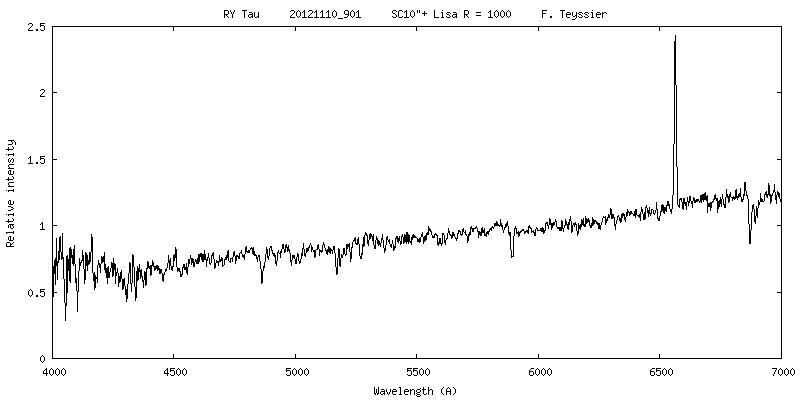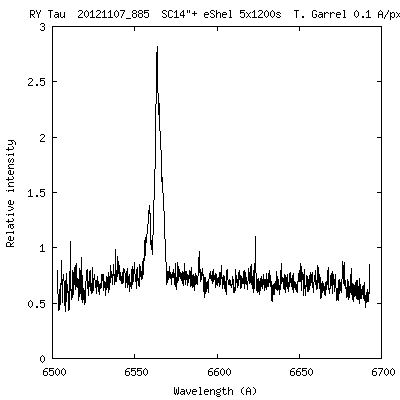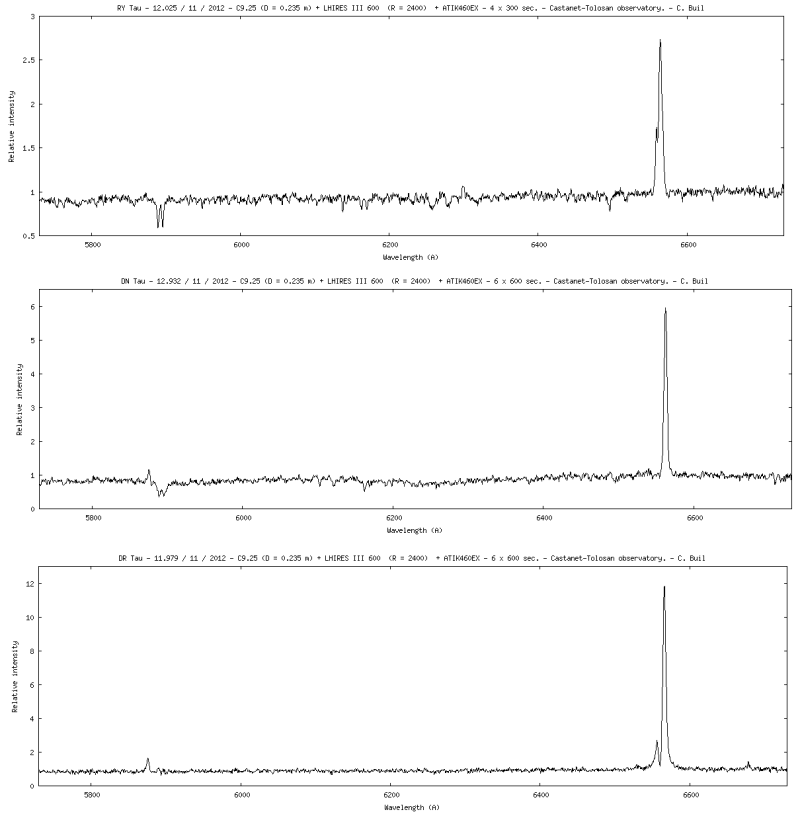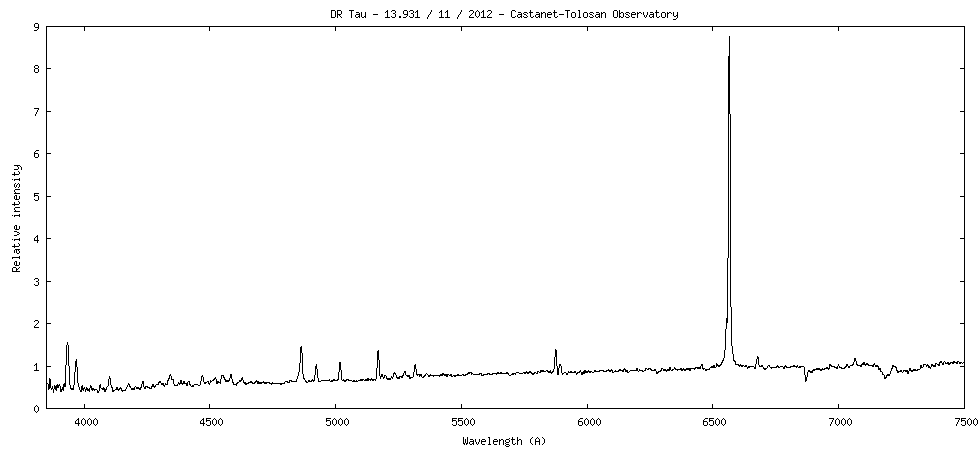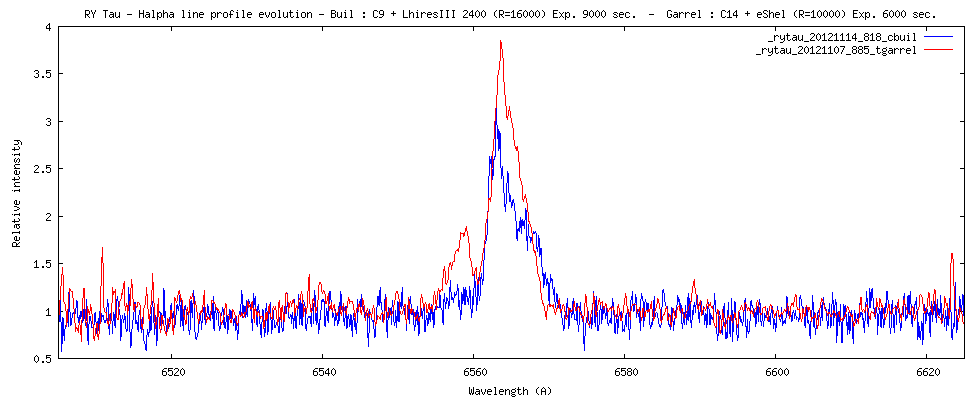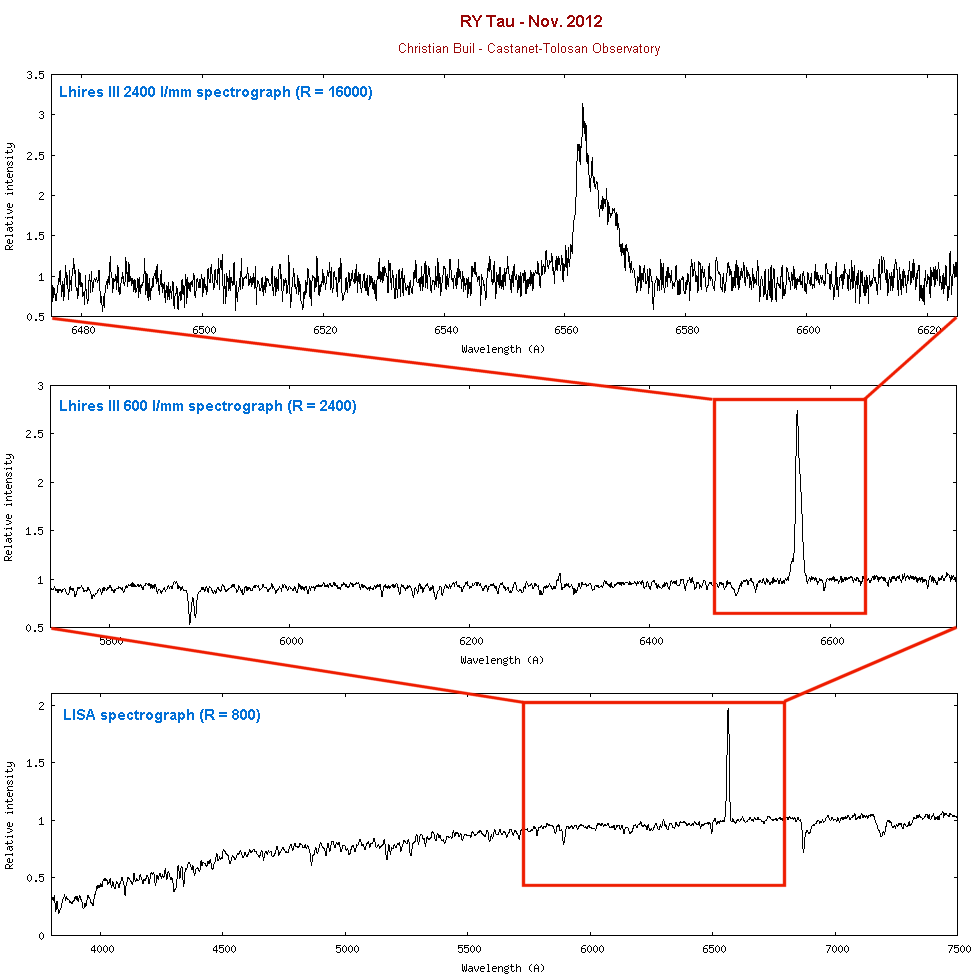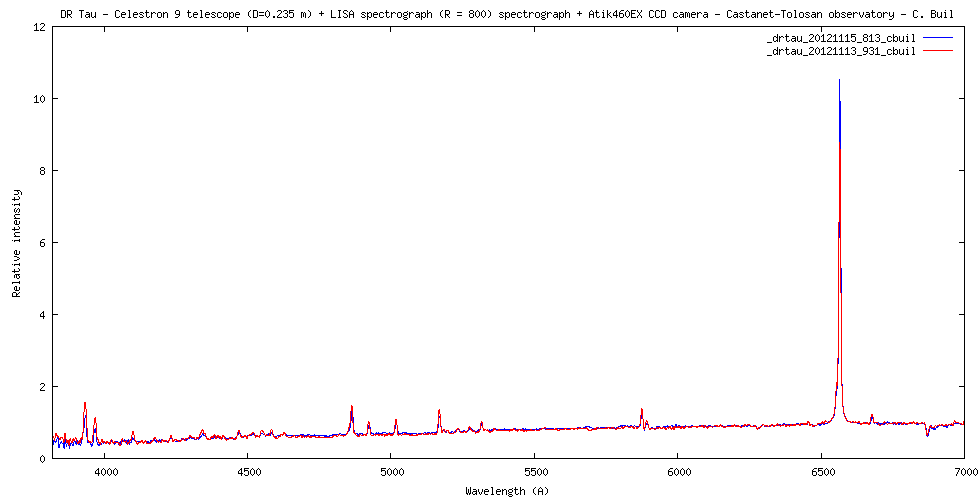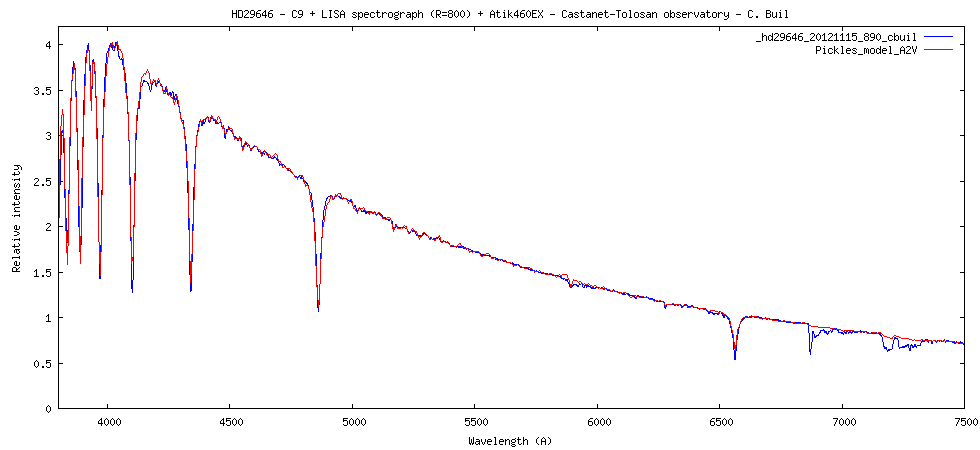RY Tau - DN Tau - DR Tau Campaign
Posted: Fri Nov 09, 2012 6:14 am
Via an alert notice of AAVSO, Darryl Sergison (University of Exeter) request spectroscopy of 3 T Tauri stars : RY Tau - DN Tau - DR Tau
Currently the magnitudes of these stars are :
RY Tau Mag V = 10.2
DN tau Mag Vis = 12.4
DR Tau Mag Vis = 12
Alert Notice 473: T Tauri stars observing campaign
November 6, 2012: Darryl Sergison (University of Exeter) has requested AAVSO assistance with a campaign he is organizing on six T Tauri stars. He writes: "In Autumn 2013 I [and my PhD supervisor Tim Naylor of Exeter University are] undertaking a new study into the nature of pre-main-sequence low mass stars, using time series optical spectroscopy and UV-Visual-IR photometry...to build a clearer picture of the environment around young solar-type stars and characterise their various disc, accretion, and outflow structures.
"This study offers a great opportunity for professional-amateur collaboration as the objects (with V magnitudes of 10 - 13) are well within the reach of photometry by small telescopes. Amateur observations are uniquely useful to us in the study of chaotically variable young stars as they offer crucial datapoints in the lightcurve between observations made by professional telescopes.
"We would be very keen to recruit(!) AAVSO observers who are interested in being part of this study and able to contribute visual or (V and Rc band) filtered CCD photometry. All contributing observers will be acknowledged in the published papers, significant contributors may also be co-authors. I do have one spare 1.25" V band filter that I could lend to any interested observer who may wish to borrow it for the duration of this programme. [If you are interested in borrowing it please email eowaagen@aavso.org].
"In preparation for the main data collection next autumn, we would like to start monitoring targets immediately. The first 3 targets that we will be studying are RY Tau, DN Tau, and DR Tau [the other 3 targets will be announced later]...
"As far as observations go, almost anything is useful. We are hoping to investigate periodicity for a range of phenomena on timescales of months to hours, so visual estimates ranging from monthly to twice in a night would be great.
"Filtered CCD measurements in any of B, V, Ic, or Rc would be great, again low cadence is useful, higher cadence (hourly or long time series) is better! Unfiltered is probably of less use to us due to the difficulties with system response and changing air-mass.
"Spectroscopy would be very welcome, particularly around H-alpha (6563Å) if the resolution is greater than a few thousand. Alternatively, low resolution right across the optical would be great (for example with a diffraction grating in the converging beam), particularly if a nearby main sequence star of similar spectral type can be captured at a similar time and air-mass so that we can characterise the system and atmosphere response at the time of the observation."
Coordinates (2000) Range B-V
RY Tau RA 04 21 57.41 Dec +28 26 35.6 9.3-13.0 p 1.0
DN Tau RA 04 35 27.38 Dec +24 14 58.9 11.5-14.7 p 1.4
DR Tau RA 04 47 06.22 Dec +16 58 42.8 10.5-16 B 1.2
Reference stars for atmospheric and instrumental response :
7 November 2012: Further to AAVSO Alert Notice 473 (www.aavso.org/aavso alert-notice/473), Principal Investigator Darryl Sergison (University of Exeter) requests that spectroscopists planning to observe the targets RY Tau, DN Tau, and/or DR Tau image the corresponding telluric standards below at the same time:
Telluric standard for RY Tau
HD 283567 B9 Vmag = 10.38 RA 04 20 33.072 Dec +28 39 08.55
Telluric standard for DN Tau
HD 284571 A0 Vmag = 9.71 RA 04 37 46.253 Dec +24 02 45.93
Telluric standard for DR Tau
HD 286036 A0 Vmag = 10.54 RA 04 46 26.684 Dec +15 59 45.47
Imaging these objects at the same time as the targets will enable the removal of the effects of system response and atmospheric absorption.
Coordinates (2000)
RY Tau RA 04 21 57.41 Dec +28 26 35.6
DN Tau RA 04 35 27.38 Dec +24 14 58.9
DR Tau RA 04 47 06.22 Dec +16 58 42.8
Currently the magnitudes of these stars are :
RY Tau Mag V = 10.2
DN tau Mag Vis = 12.4
DR Tau Mag Vis = 12
Alert Notice 473: T Tauri stars observing campaign
November 6, 2012: Darryl Sergison (University of Exeter) has requested AAVSO assistance with a campaign he is organizing on six T Tauri stars. He writes: "In Autumn 2013 I [and my PhD supervisor Tim Naylor of Exeter University are] undertaking a new study into the nature of pre-main-sequence low mass stars, using time series optical spectroscopy and UV-Visual-IR photometry...to build a clearer picture of the environment around young solar-type stars and characterise their various disc, accretion, and outflow structures.
"This study offers a great opportunity for professional-amateur collaboration as the objects (with V magnitudes of 10 - 13) are well within the reach of photometry by small telescopes. Amateur observations are uniquely useful to us in the study of chaotically variable young stars as they offer crucial datapoints in the lightcurve between observations made by professional telescopes.
"We would be very keen to recruit(!) AAVSO observers who are interested in being part of this study and able to contribute visual or (V and Rc band) filtered CCD photometry. All contributing observers will be acknowledged in the published papers, significant contributors may also be co-authors. I do have one spare 1.25" V band filter that I could lend to any interested observer who may wish to borrow it for the duration of this programme. [If you are interested in borrowing it please email eowaagen@aavso.org].
"In preparation for the main data collection next autumn, we would like to start monitoring targets immediately. The first 3 targets that we will be studying are RY Tau, DN Tau, and DR Tau [the other 3 targets will be announced later]...
"As far as observations go, almost anything is useful. We are hoping to investigate periodicity for a range of phenomena on timescales of months to hours, so visual estimates ranging from monthly to twice in a night would be great.
"Filtered CCD measurements in any of B, V, Ic, or Rc would be great, again low cadence is useful, higher cadence (hourly or long time series) is better! Unfiltered is probably of less use to us due to the difficulties with system response and changing air-mass.
"Spectroscopy would be very welcome, particularly around H-alpha (6563Å) if the resolution is greater than a few thousand. Alternatively, low resolution right across the optical would be great (for example with a diffraction grating in the converging beam), particularly if a nearby main sequence star of similar spectral type can be captured at a similar time and air-mass so that we can characterise the system and atmosphere response at the time of the observation."
Coordinates (2000) Range B-V
RY Tau RA 04 21 57.41 Dec +28 26 35.6 9.3-13.0 p 1.0
DN Tau RA 04 35 27.38 Dec +24 14 58.9 11.5-14.7 p 1.4
DR Tau RA 04 47 06.22 Dec +16 58 42.8 10.5-16 B 1.2
Reference stars for atmospheric and instrumental response :
7 November 2012: Further to AAVSO Alert Notice 473 (www.aavso.org/aavso alert-notice/473), Principal Investigator Darryl Sergison (University of Exeter) requests that spectroscopists planning to observe the targets RY Tau, DN Tau, and/or DR Tau image the corresponding telluric standards below at the same time:
Telluric standard for RY Tau
HD 283567 B9 Vmag = 10.38 RA 04 20 33.072 Dec +28 39 08.55
Telluric standard for DN Tau
HD 284571 A0 Vmag = 9.71 RA 04 37 46.253 Dec +24 02 45.93
Telluric standard for DR Tau
HD 286036 A0 Vmag = 10.54 RA 04 46 26.684 Dec +15 59 45.47
Imaging these objects at the same time as the targets will enable the removal of the effects of system response and atmospheric absorption.
Coordinates (2000)
RY Tau RA 04 21 57.41 Dec +28 26 35.6
DN Tau RA 04 35 27.38 Dec +24 14 58.9
DR Tau RA 04 47 06.22 Dec +16 58 42.8
